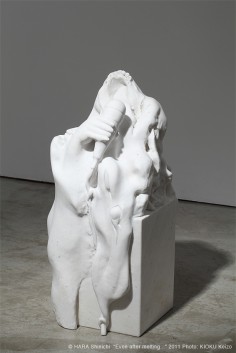SHINICHI HARA
Even after melting
source: shinichi-hara
多摩美術大学客員講師、東京デザイナー学院特別講師 ロボット大賞2007(経済産業省より)受賞 実用科学賞(ロボット学会より)受賞 音楽ロボット”MIURO”をデザインし、それが日本国総理御用達となり外国の大統領級の方へのギフト商品となる。
25年間に渡りデザインしたCD、レコードの総売上枚数は1億枚に達する。
.
.
.
.
.
.
.
source: union-gallery
The techniques employed by Shinichi Hara in producing his stone sculptures feels slightly different to simply engraving or carving a shape. Perhaps it can be best described as handling stone as thought it were a soft piece of material. Surprisingly, this does not represent a conditionction. After all, marble has always had a milky texture, as it would genty swallow your hand if you reached out to touch it.
The multiple draping woven into Hara’s sculpture is some how reminiscent of the agitated surface of white, opaque liquid. Marble and milk- this is, however, not simply an association based on a visual image. Come to think of it regardless of how hard and unchangeable stone may appear to be, if it were to be observed over a long period of time, one would see that it is constantly changing shape, wriggling, fluid. It can also be compared to hot magma. In other words, although it may appear to be stone, within the context of global time it is just another phenomenon that is fluid in form. Fluidity has always been latent within stone but as we do not live in global time we are normally unable to experience this. There are however, no two identical stones. Stones may appear to be nothing more than lumps, but in fact they are product of a process in which time has been removed in a instant, one shape undergoing a shift into another shape. An a stone sculpture indeed is the manifestation of shape. Beyond this, however, there is arguably also a process in which the flow of time within the stone is experience by and understood through touch. Hara’s sculpture rather refers to this temporal quality, the fluidity, transience and perpetual nature of stone. The sculptures that Hara carves represent movement rather than form. As a result, it would be perfect natural if the end result were a detail of the human body, a cartilage- like, ear-like shape. Hara’s sculpture is like an eternal cross-section that is glimpsed within transience, fragility, as though flowing against the current of eternal form that is seen as the ideal of many stone sculptors.


